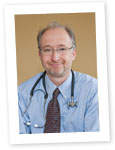In Search of a Cure for HIV – A Short Interview with Dr. Steven Deeks
| Dr. Steven Deeks is a highly respected clinician and scientist whose work encompasses both clinical care and research into the pathogenesis and treatment of HIV infection. He is a Professor of Medicine in Residence at the University of California, San Francisco (UCSF) and a faculty member in the Positive Health Program (AIDS Program) at San Francisco General Hospital. Dr. Deeks is visiting Amsterdam for the NCHIV 2011 conference on 29 November 2011. During the conference, Dr. Deeks will be speaking on “Prospects for HIV eradication”. He kindly agreed to speak to us about his work at UCSF and San Francisco General Hospital, his study on the possibility of a cure for HIV, and his involvement with various cohort studies. |
|
What are you working on at the moment?
Steven Deeks: "I currently focus about twenty percent of my time on the critical care of around 100 patients at San Francisco General Hospital. The rest of my time is principally spent on directing the SCOPE cohort. SCOPE is a relatively large cohort with around 1500 enrolled subjects, both HIV-infected and uninfected. Given the interest of our collaborators, the cohort has been enriched for a variety of unique groups, including elite controllers and long-term immunologic non-responders. Our cohort is also able to support focused clinical trials. To date about 10 small intensive clinical trials have been carried out, each involving 20 to 50 people, and have been essentially hypothesis generating trials."
During your presentation at NCHIV you will talk about two potential types of cure: sterilizing and functional cure. Could you explain a little about your research regarding these cures?
(Editor’s note: While antiretroviral therapy has greatly improved the lives of those infected with HIV, it cannot cure HIV. As a result, HIV therapy is life-long. Life-long therapy may lead to long-term complications, and strictly adhering to taking medications for so long may also be a problem. Researchers are therefore looking into how HIV could be cured through two potential methods of cure. The sterilizing cure method involves the elimination of all HIV-infected cells while the functional cure method involves the long-term control of HIV in the absence of therapy.)
Steven Deeks: "The process of finding a cure for HIV is extremely complex. Several issues have to be addressed. We need to define where HIV persists in the body in terms of tissue and cell types. We need to define the relative roles of various mechanisms for persistence, including the role of HIV replication, chromatin silencing and homeostatic proliferation. We need to determine if virus production results in the death of infected cells. Finally, and of high interest to our group, we need to define whether chronic inflammation contributes to HIV persistence. Our group has several studies aimed at determining if chronic inflammation leads to HIV persistence or whether HIV persistence leads to chronic inflammation. We are also studying the impact of both inflammation and persistence on clinical outcomes."
Timothy Ray Brown, known as the “Berlin Patient”, is currently living in San Francisco and is involved in your cohort. He may be the first person ever to have been cured of HIV. Can you tell me how he contributes to the further study of HIV cures?
Steven Deeks: "Tim Brown is a study participant in the SCOPE cohort and is extremely supportive of any research related to cure. In collaboration with the team who performed the initial study, we are currently investigating how he was cured and what the long-term effects are of his treatment. Although his treatment is not feasible for the vast majority of people with HIV, his case is important in investigating a potential sterilizing cure."
The ATHENA cohort, conducted by the Dutch HIV monitoring foundation (Stichting HIV Monitoring), is a comprehensive study of the HIV epidemic in the Netherlands. Do you know of the ATHENA cohort and is it applicable to your work?
Steven Deeks: "I’m a fan of the ATHENA cohort. Of the established multicentre cohorts it is one of the largest. From a clinical perspective, I was particularly interested in early findings regarding the potential unique role of protease inhibitors on immunologic outcomes during therapy. I was also impressed by the recent work suggesting that the goal of therapy might be to achieve a CD4 cell count above 800 cells/mm3 rather than 500 cell/mm3, as the former is apparently associated with normal life expectancy. These and other ATHENA studies have had a direct impact on my work."
Are there other national studies similar to ATHENA being conducted in the United States and are you involved in these studies?
Steven Deeks: "There are two efforts to develop national cohort studies through joining together multiple smaller cohorts throughout the United States. They are NA-ACCORD (North American AIDS Cohort Collaboration on Research and Design) which incorporates clinical data from cohort studies throughout the United States and Canada, and CNCIS (CFAR Network of Integrated Clinical Systems) which provides comprehensive data including biological specimens. Both studies are quite successful. They are perhaps not as precise as ATHENA as data has to be collected from a variety of sources and then assimilated. The SCOPE cohort that I co-direct with Dr. Jeff Martin shares data with both of these cohorts."

